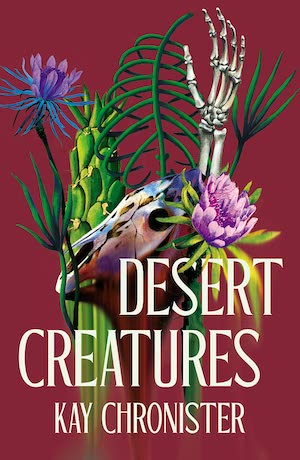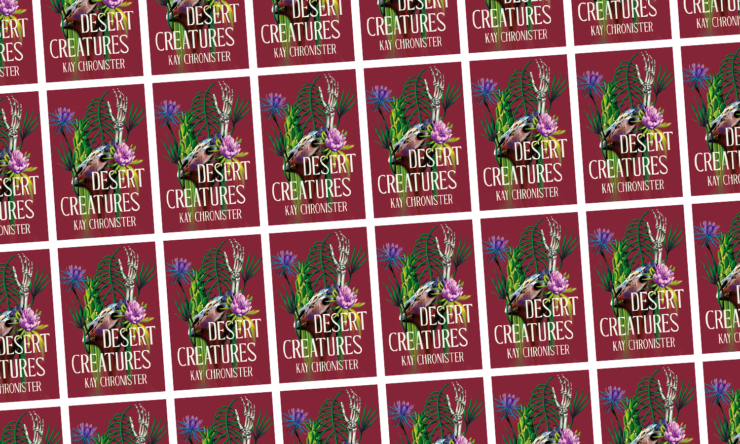There’s a small cluster of books that came to mind when reading Kay Chronister’s Desert Creatures—novels about the western United States when the future has curdled into something brutal. The ecological nightmares of Claire Vaye Watkins’s Gold Fame Citrus, Diane Cook’s The New Wilderness, and Edan Lepucki’s California all come to mind when reading Chronister’s book—but there’s something else in its DNA as well that makes this fit imperfect. Chronister’s novel also hearkens to the genre-shredding vistas of Grace Krilanovich’s The Orange Eats Creeps, Jeff VanderMeer’s Southern Reach trilogy, and Sue Rainsford’s Redder Days—but its horrors aren’t entirely of a piece with either of these books as well.
Still, there are comparisons to be made here. And it turns out talking about something in terms of what it both is and is not is an apropos starting point for discussing Chronister’s novel. This is, after all, a novel where relics abound, where faith takes bizarre turns, and where strange amalgamated creatures roam a desiccated landscape. This is a book in which religion and mysticism are paramount and where numerous characters lack the precise words to describe that which they encounter, or just what led to the ruin of the civilization that collapsed long before they were born.
Did I mention that there’s also the danger of being absorbed into a nightmarish composite being including cacti, human bodies, and animal corpses? Because that’s a concern as well. Magdala, the protagonist of Desert Creatures, is a young girl when the book opens, and whether or not she’ll survive to see adulthood is one of this novel’s central concerns in its first part.
Buy the Book


Desert Creatures
Desert Creatures opens in motion—first, the motion of a fire as it moves through the space where Magdala and her father Xavier are living, and then the motion of father and daughter as they escape the community that’s turned on them. “From a distance, they might have been one two-headed creature,” Chronister writes, a harbinger of the nightmarish forms to come. As they make their way through the desert, they come across the first sign that the rules of this world are very different from our own:
“Midafternoon, when their mouths were stuck shut and their hopes running thin, they came suddenly to a forest of cactus arms wrapped around each other: thin and sinewy and curling from the trunk of a limbless human form in a dust-crusted denim shirt. Rising from the arms were red flowers with wide yellow stamens. Some were young and thin, but others looked mature, even near-rotting, and from these hung heavy, knuckle-shaped fruits.”
Xavier explains that this was once a man. “He died and the desert got inside him,” he tells his daughter. Parched, she eats several of the aforementioned fruits—and before long, it will have made her ill, forcing Xavier to seek refuge in a nearby town. That town has the ominous name of Caput Lupinum; literally translated, it means “Wolf’s Head,” and it’s home to a host of escaped outlaws.
It’s also the most traditionally dystopian setting within the book, where the town’s women are branded with the names of the town’s men and where visitors have a tendency to stay for far longer than they initially planned. It’s also here that Magdala begins to hear stories of saints, pilgrims, and miracles—several characters point to her clubfoot and wonder if she’s in search of the bones of a saint. In this devastated landscape, Las Vegas has become a holy city, and different religious factions interpret the breakdown of society in different ways. Besides the pilgrimages that are referenced often and a sect of monks who loom large later in the novel, Magdala and her father also repeatedly encounter a sect of men who spend their time sitting atop cacti in the middle of the desert. It’s one of many stunning images that comes to the forefront in the pages of Chronister’s novel.
Without spoiling too much, I’ll say that Magdala faces a few nearly-impossible moral decisions, and eventually leaves Caput Lupinum behind. Eventually, she crosses paths with Arturo, a heretic priest whose memories of his younger life offer some details on how this ever-shifting future came to be—and who offers a very different perspective on the clashing factions in the Mojave and Sonoran Deserts. He also may be able to perform miracles.
If the references to priests and a character named Magdala—to say nothing of an opening scene in which consuming fruit has significant consequences—aren’t enough of an indication, I’ll state it outright: this is a novel deeply steeped in Old and New Testament imagery. (I haven’t even brought up a supporting character named Barabbas Knight.) Desert Creatures’ version of religion isn’t simply a riff on the Abrahamic faiths, though Biblical imagery dominates; there’s also a story told early on about the Hopi god Masauwu.
The references to Old and New Testament images aren’t just there for set dressing. At its best moments, Desert Creatures is a story of both creation and apocalypse, where characters struggle with both belief and heresy. Much as the novel itself has elements of both speculative fiction and horror. G.K. Chesterton, another writer who knew something about weaving religious imagery in their work, subtitled his novel The Man Who Was Thursday “A Nightmare.” Chronister could have applied a similar description to this unsettling book.
Desert Creatures is published by Erewhon.
 Tobias Carroll is the managing editor of Vol.1 Brooklyn. He is the author of the short story collection Transitory (Civil Coping Mechanisms) and the novel Reel (Rare Bird Books).
Tobias Carroll is the managing editor of Vol.1 Brooklyn. He is the author of the short story collection Transitory (Civil Coping Mechanisms) and the novel Reel (Rare Bird Books).










